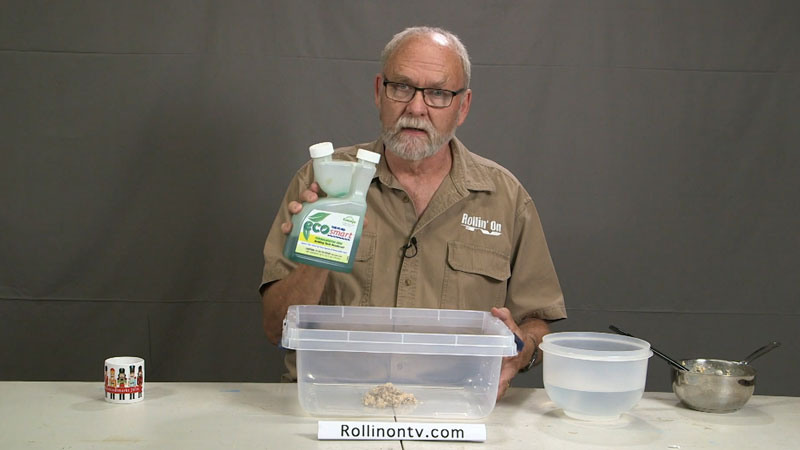Q: “I have a friend who says he always puts some fresh water in his black tank after he dumps it. He says this helps him dump the tank the next time. Is this true, or a myth of some kind?””.
RV Straight Talk with Jeff Johnston
Is Pre-Charging a Black Tank a Myth or True?
A: I’m Jeff Johnston for, “Rollin’ On TV,” and welcome to RV Straight Talk, where I’ll try and answer your RV technical and, at times, not so technical questions. You can submit your questions by email to jeff@rollinontv.com, or by simply going to our website at rollinontv.com and clicking on the RV Straight Talk link. This may not be something that many RVers are comfortable discussing, but the waste tank holding system is an important piece of gear. Keeping it in good operating condition can help avoid nasty problems later on.
This week, Jerry writes, “I have a friend who says he always puts some fresh water in his black tank after he dumps it. He says this helps him dump the tank the next time. Is this true, or a myth of some kind?”
From Jerry in Charlevoix.
A: Well, that’s beautiful country where you live, Jerry. We’ve been through there several times, we enjoy it every time.
Yes, it’s true, Jerry. It’s a good idea, and it’s something I do every time. It’s called pre-charging the tank. After dumping, I add about two or three gallons of fresh water depending on the size of the tank, plus the toilet chemical in the empty black tank. Now, let’s head out to the shop and I’ll show you how that works and why it’s a good idea.
Not surprisingly, when it comes to your RV’s waste system, your number one problem is going to be number two. So, there’s a simple step you can take, pre-charging the tank, that’ll make things a whole lot easier down the road. Most RV holding tanks are fairly broad and flat, not too tall, because they fit between the rails of an RV between the floor and the belly pan. So, there’s not a lot of depth to them.
 But here we have a kind of a broad, flat pan, representing your holding tank. And say, for example, you put some post-processing oatmeal in the tank. Maybe a little more. And depending on the nature of your oatmeal, it can be fairly adhesive sometimes. So, you drive down the road, and you probably at some point put in a little bit of Eco-Smart or some other brand of holding tank chemical, which is a good idea. You may also throw a little bit of water in there, fluid that goes along with flushing the toilet, although there’s nowhere near as much as in a residence. So, you get a little bit of water in there, and that water is also sloshing around. And then you go to the dump station. Maybe you’ve had several piles of oatmeal put in there of different viscosities. So, you go to dump and, well, takes a little bit of effort to get the oatmeal out of the holding tank because there isn’t enough fluid in there to flush it out effectively.
But here we have a kind of a broad, flat pan, representing your holding tank. And say, for example, you put some post-processing oatmeal in the tank. Maybe a little more. And depending on the nature of your oatmeal, it can be fairly adhesive sometimes. So, you drive down the road, and you probably at some point put in a little bit of Eco-Smart or some other brand of holding tank chemical, which is a good idea. You may also throw a little bit of water in there, fluid that goes along with flushing the toilet, although there’s nowhere near as much as in a residence. So, you get a little bit of water in there, and that water is also sloshing around. And then you go to the dump station. Maybe you’ve had several piles of oatmeal put in there of different viscosities. So, you go to dump and, well, takes a little bit of effort to get the oatmeal out of the holding tank because there isn’t enough fluid in there to flush it out effectively.
Pre-charging the holding tank essentially means you start with– I usually use two or three gallons of fresh water. You lose a little bit of your holding tank capacity, but in terms of what it does to help provide more effective flushing, you can’t beat it, it’s worth it. And you really don’t have that much volume that goes in there unless you’re out for a very long time dry camping. So, with a little bit of water in there, you have a little more oatmeal that goes in. Maybe a little bit more. Then you drive down the road, and lo and behold, the oatmeal is stirring around in the holding tank. Hmm, isn’t that nice? Well, so to speak. So, then when you go to dump it, flushes right out of the tank smoothly and effectively. So, if you put just two or three gallons of fresh water in after you dump the tank, the fresh water also helps your holding tank chemical to spread out and distribute, and distribute among the oatmeal to help treat the oatmeal so it, you know, smells pretty. And that essentially is what pre-charging your holding tank vis all about, and why you would want to do it.
That about covers it, Jerry

